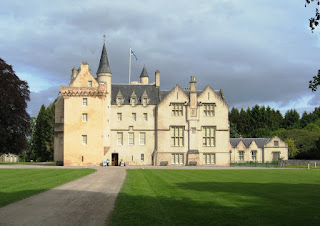Exploring Scotland 1 Castle at a Time, Part 18, Brodie Castle
We arrived at Brodie Castle too early and it wasn’t open, but we still wandered around and enjoyed the grounds and took pictures of the castle and of course the Rodney Stone.
Malcolm, Thane of Brodie, was an ancestor of the Pictish aristocracy and there is evidence that he was in possession of the land in 1160. Because of the right of ancestory, Robert the Bruce chartered the property to Malcolm’s son Michael. The castle was constructed in 1567 and 35 generations of Brodies lived in it until recently. It is under the protection of Historic Scotland and the Brodie heirs no longer live there.
Mary Queen of Scots for a brief time confiscated the property when the 12 Earl, a Presbyterian, voiced his opposition to her rule.
In 1645 Lord Lewis Gordon plundered and burnt the castle because the 15th Earl, Alexander, was a Covenanter. ( A covenanter was a Presbyterian who had signed a covenant to uphold that the Presbyterian faith was the sole religion of their country.) Documents that recorded the Brodie lineage were destroyed.
Alexander also helped destroy paintings and carvings in Elgin Cathedral because he thought them idolatrous. He went on to participate in negotiations with Charles II at Breda and the Hague in 1649-1650 and incurred a large debt on Charles behalf for which he wasn’t repaid. The family struggled for generations to pay for the castle’s upkeep.
In 1832 the 24th Earl married a wealthy heiress and it was she who paid for the repairs that were done in 1824 to both the grounds and the castle and wiped out the debt that burdened the Brodie family.
The 1567 castle was incorporated an earlier structure into its design. The five story towers are from that time, while the long extension on the right was designed in 1824 by William Burn. I enjoyed the Victorian dairy Historic Scotland had renovated. And enjoyed reading about who worked at it and etc.
Malcolm, Thane of Brodie, was an ancestor of the Pictish aristocracy and there is evidence that he was in possession of the land in 1160. Because of the right of ancestory, Robert the Bruce chartered the property to Malcolm’s son Michael. The castle was constructed in 1567 and 35 generations of Brodies lived in it until recently. It is under the protection of Historic Scotland and the Brodie heirs no longer live there.
Mary Queen of Scots for a brief time confiscated the property when the 12 Earl, a Presbyterian, voiced his opposition to her rule.
In 1645 Lord Lewis Gordon plundered and burnt the castle because the 15th Earl, Alexander, was a Covenanter. ( A covenanter was a Presbyterian who had signed a covenant to uphold that the Presbyterian faith was the sole religion of their country.) Documents that recorded the Brodie lineage were destroyed.
Alexander also helped destroy paintings and carvings in Elgin Cathedral because he thought them idolatrous. He went on to participate in negotiations with Charles II at Breda and the Hague in 1649-1650 and incurred a large debt on Charles behalf for which he wasn’t repaid. The family struggled for generations to pay for the castle’s upkeep.
In 1745 the 19th Earl of Brodie, another Alexander, became Lord of Lyons, King of Arms, responsible for the heraldry in Scotland. His wife Mary Sleigh designed the gardens around the castle.
In 1832 the 24th Earl married a wealthy heiress and it was she who paid for the repairs that were done in 1824 to both the grounds and the castle and wiped out the debt that burdened the Brodie family.
The 1567 castle was incorporated an earlier structure into its design. The five story towers are from that time, while the long extension on the right was designed in 1824 by William Burn. I enjoyed the Victorian dairy Historic Scotland had renovated. And enjoyed reading about who worked at it and etc.
It gave me a feel for how a real castle worked with the herb garden, the dairy, you could picture how such a place could be self sufficient.
Tomorrow I'll be talking about Tolquhon Castle.
Write on,
Teresa R.











Comments
Sorry but being a Presbyterian who lost ancestors to the convenanting movement have to speak up.
Cherie Le Clare
Thanks for expanding on my definition of a covenanter. I appreciate your understanding of Scottish history and enjoy it when you step in to go further into depth on the subject.
Teresa R.
I attended a wedding at Brodie Castle (as part of an RT trip there in 2002) and we were shown the letter from Robert the Bruce to the Thane of Brodie!
Terri B